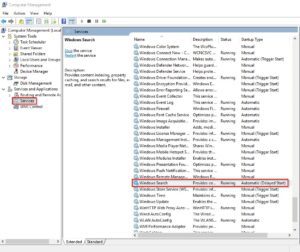How to Enable File Indexing in Windows 10
Enable File Indexing Whether you’re looking for a faster way to find files on your computer or trying to troubleshoot a search problem, file indexing can be a useful tool.
Indexing allows you to search for files by their properties or their contents. To enable this, you must first modify the settings for a specific drive or folder.
Enabling file indexing can significantly enhance the search capabilities of your operating system, making it quicker and more efficient to find files. The process differs slightly between Windows and macOS. Below are step-by-step instructions for both systems.

Windows:
Step 1: Access Indexing Options
- Click on the Windows Start button and type “Indexing Options” in the search bar.
- Select “Indexing Options” from the search results.
Step 2: Modify Indexing Settings
- In the Indexing Options window, click on the “Modify” button. You might need administrative privileges to make changes.
- A list of locations will appear. Ensure that the folders containing the files you want to index are checked. You can add or remove folders as needed.
- Click “OK” to save your changes.
3: Customize Indexed Locations
- To further customize indexed locations, click on the “Advanced” button in the Indexing Options window.
- Here, you can choose which file types should be indexed, among other options. Adjust the settings according to your preferences.
- Click “OK” to apply the changes.
Step 4: Monitor Indexing Status
- Return to the main Indexing Options window. You can monitor the indexing progress and make additional changes if necessary.
macOS:
Step 1: Open Spotlight Preferences
- Click on the Apple menu in the top-left corner of the screen and select “System Preferences.”
- Click on “Spotlight.”
2: Customize Spotlight Settings
- In the Spotlight preferences window, go to the “Privacy” tab.
- By default, Spotlight indexes your entire disk. To modify this, click the “+” button and select the folder(s) or disk(s) you want to include or exclude from indexing.
- Close the Spotlight preferences window.
3: Allow Indexing to Occur
- After modifying the Spotlight settings, the system will automatically start indexing the selected locations. This process might take some time, especially for larger volumes of data.
Step 4: Monitor Spotlight Indexing
- You can monitor the indexing progress by clicking on the Spotlight icon in the menu bar. A spinning icon indicates that indexing is in progress.
General Tips:
- Be Patient: Indexing large amounts of data can take time. Allow the process to complete before expecting full search functionality.
- Optimize Indexing: Include folders that contain the most frequently accessed files for efficient searches.
- Regularly Update Index: Add or remove folders/files from the indexed locations as your data changes to ensure accurate search results.
How to enable indexing
If you’re having trouble finding files on your computer or need to quickly troubleshoot a search problem, it can be very helpful to turn on file indexing in Windows 10. This will make it much easier to access and find files by creating an index of the contents of your drives. Enable File Indexing
You can enable file indexing in a few easy steps. Start by opening the Search bar and typing “Indexing options.” Click on the top result and open the Indexing Options window. From here, select the drive or folder you want to add to your index and click Modify.
You can also use this window to disable indexing for specific folders. This can help reduce the amount of CPU and RAM resources used by the indexing process. It can also save space on your hard drive by reducing the size of the indexed data.
What is file indexing?
File indexing creates a searchable database of your files so that you can find them quickly. It enables users to access documents based on any attribute or label, such as document name, record number, date or department. It is particularly important for businesses that have gone paperless, as it reduces the risk of compliance violations by allowing teams to locate files quickly and easily.
The index is updated continually as new files are added or modified. The index also stores metadata such as the date and time a file was changed, or whether it contains text, or a description of its contents.
If you do not need search capabilities for a particular drive or partition, you can disable indexing by opening the drive in Windows Explorer and right-clicking it. In the Indexing options window, click Advanced. Uncheck the locations you do not want to be indexed and click OK. This can significantly reduce the amount of resources that Windows uses to build and update your search index.
Indexing options
By default, Windows indexes all file properties and locations including full path information. It also indexes text in files allowing you to search by words within the file content itself.
Apps you install can add their own information to the index speeding up searching. For example, email apps like Outlook may add all emails synced to the machine to the index for faster searching.
You can use the ‘Indexing options’ tool to modify where your index is stored and which locations are indexed. This helps you to save RAM and CPU resources. However, you will need to keep some locations indexed as searches without an index can take longer than with an index. The tool also provides options for disabling indexing for folders you don’t regularly use. This reduces the storage strain on your drives but can increase background process execution and delay finding files until the index updates. You can also choose whether to index encrypted files and treat diacritics differently from the same word.
Indexing encrypted files
When Windows indexes folders, it creates a database of files keyed by search terms (plain text words). This makes it faster to access certain kinds of content on your computer. Indexing does affect performance, so you can enable or disable it based on your needs.
If you use file encryption such as BitLocker, you might want to make sure that your encrypted files are indexed as well. In this post, we’ll show you how to do that on a Windows 10 PC.
You can change the settings for the index, including whether to include encrypted files and whether or not to treat similar words that have diacritics as different words. You can also change where the index is stored.

Leave a Reply